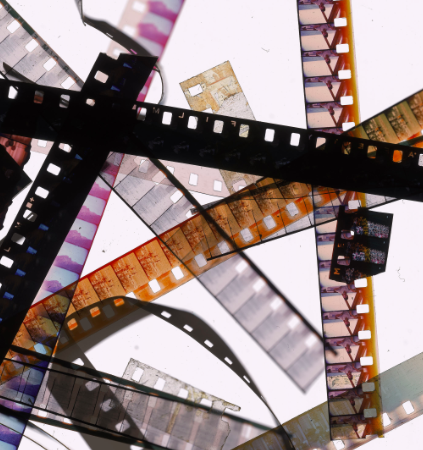Step Two: Camera’s Rolling!
 OK…let’s start the recoding process. Feed the film in the projector; turn the camcorder to CAMERA mode (remember to turn off the on-screen graphics features), start-up the software app on the computer; give a name to the first video recording (with no physical label on the reel - which most do not have - you may need to watch the first part just to see what the film is about) & click “start”; turn on the projector lamp; turn projector control to FORWARD; and check that all is in focus (the best you can).
OK…let’s start the recoding process. Feed the film in the projector; turn the camcorder to CAMERA mode (remember to turn off the on-screen graphics features), start-up the software app on the computer; give a name to the first video recording (with no physical label on the reel - which most do not have - you may need to watch the first part just to see what the film is about) & click “start”; turn on the projector lamp; turn projector control to FORWARD; and check that all is in focus (the best you can).
Wait…what’s all that flicker in the video? Turns out that since the film is being projected at 18 frames per second and the video camcorder is recording at 30 frames per second (the standard for TV), there is a pronounced flicker in the final product. I found that this is quite common in amateur and low-budget conversion processes (of which I am both), and there are outside services which may charge up to $0.50 per foot of film to transfer the film and theoretically eliminate the flicker. Since we have over 3300 feet of film, and knowing the Bules Vintage Films is a low-budget operation, we’ll just try and minimize the flicker.
I found a shutter speed adjustment on the camcorder which when adjusted will not eliminate the flicker…but it reduces the effects somewhat. **SIGH** Just another adjustment needed to be made when the recording process is started.
The Recording Process Goes Awry
All of sudden the projector goes into it’s “Aw...crap, the film just broke” mode. Stop the projector; turn the bulb off; ignore the camera…it’s fine; stop the computer software app (which processes what it already has recorded, stores the resulting video on the hard drive, and get’s ready for the next recording process).
 Un-stick the film from the projector, cut out what is obviously damaged, splice back together the remaining parts, re-feed the film back into the projector, and rewind the projector a few seconds so as to pick up where you left off (as close as you can).
Un-stick the film from the projector, cut out what is obviously damaged, splice back together the remaining parts, re-feed the film back into the projector, and rewind the projector a few seconds so as to pick up where you left off (as close as you can).
Restart the process again: Projector FORWARD, bulb ON, re-start the software app by giving it the next part of the film a new name (like same name only part 2) and click through the menu to start another recording process, and finally pray to the film God you can make it to the end without another breakage.
Other interesting variations of the playbook include film stutter, which is what happens when the film holes are too worn and the projector sprockets can’t get a firm grip. The film starts jumping up and down trying to work through the sprocket feed. You might be able to clear the problem by stopping the projector, rewinding it a bit, then going forward again in a naive attempt to ignore the previous problem (the film must have been simply confused). Leaving the computer software running will record your foolish attempts at restarting the film.
What for Audio?
The output of the camcorder and the input to the Roxio digitizer include connections for video as well as stereo audio signals. Not thinking about what I was doing, I plugged in all of the connections and started the recording process. When playing back the very first recorded video, I then realized that 8mm film does not have any audio - it is silent movie technology. The camcorder, however, does have audio recording (for its VHS tapes), so what I got was a very nice audio recording of the projector chugging away. Unplugging the audio cables solved that problem, however, one of the first films recorded still has some projector noise in the background.
Space/Time Continuum
Without some pre-planning, you may be in jeopardy of destroying the whole space/time continuum as we know it (or at least as I know it). This whole film-to-DVD process uses a very large amount of hard drive space. This project involves around 50 film reels providing just under 5 hours of movies. Digitizing each film reel requires between 300 - 400 mbytes of storage. Just this first initial phase of recording will require nearly 25 Gigabytes of storage. By the time we get through the editing process, voice overs, final video conversion, and disk imaging copies, nearly 100 GBytes may be required.
Plan ahead or, like me, you will be scrambling in the middle of the process trying to find more storage space. You may ask why I didn’t just use the “cloud" instead of relying on hard drive storage. The reason is that the internet speed at our location is so slow (insert slow internet joke here):
“My internet speed is so slow that….” [please hold while remaining part of joke is still loading].
The next step will be about editing.

No comments:
Post a Comment